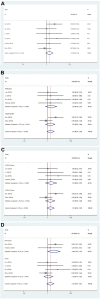Impact of early Kasai portoenterostomy on short-term outcomes of biliary atresia: A systematic review and meta-analysis
- PMID: 36117834
- PMCID: PMC9475174
- DOI: 10.3389/fsurg.2022.924506
Impact of early Kasai portoenterostomy on short-term outcomes of biliary atresia: A systematic review and meta-analysis
Abstract
Background: Good outcomes of biliary atresia (BA) are conventionally achieved after early Kasai portoenterostomy (KP). However, in some recent pieces of literature, there are discrepancies in the influence of age in Kasai procedure on postoperative short-term prognosis. This meta-analysis aims to evaluate the effects of earlier KP on short-term surgical prognosis of BA and clarify these discrepancies in recent studies.
Methods: To identify related studies, PubMed, Embase, Web of Science, Cochrane, and the Chinese National Knowledge Infrastructure database were searched up to March 2022. Data for the impact of age at KP on clinical prognosis were extracted, including jaundice clearance rate (JCR) and native liver survival rate (NLSR).
Results: A total of 14 articles were included in the present study, which involve a total of 3,276 patients with BA who underwent Kasai procedure. Compared with patients older than 91 days of age, patients 90 days of age or younger exhibited significantly better JCR [odds ratio (OR), 3.05; 95% confidence interval (CI), 2.23-4.17; P < .001] and a more favorable NLSR (OR, 1.72; 95% CI, 1.37-2.15; P < .001). The NLSR of patients younger than 60 days of age was significantly higher than those of patients from 61 to 90 days of age (OR, 1.41; 95% CI, 1.18-1.68; P < .001). There was no significant difference in JCRs between patients aged 60 days of age or younger and those aged 61-90 days of age (OR, 1.31; 95% CI, 0.95-1.81; P = 0.10). Among patients 30 days of age or younger, 31-45 days of age, and 46-60 days of age, there were also no significant differences in JCR.
Conclusion: A significantly better short-term JCR and NLSRs were achieved among patients with BA treated using a KP procedure at ≤90 days of age compared with those treated at >90 days of age. There was no further improvement in the short-term JCR when the procedure was performed at ≤60 days compared with those treated at 61-90 days of age. However, treatment at ≤60 days of age was associated with a significant improvement in NLSR. Therefore, the timing of KP does exert an important effect on short-term clinical outcomes of patients with BA.
Keywords: Kasai portoenterostomy; age at operation; biliary atresia; meta-analysis; short-term outcomes.
© 2022 Yang, Ke, Zhou, Xu, Diao and Li.
Conflict of interest statement
The authors declare that the research was conducted in the absence of any commercial or financial relationships that could be construed as a potential conflict of interest.
Figures







References
-
- Shinkai M, Ohhama Y, Take H, Kitagawa N, Kudo H, Mochizuki K, et al. Long-term outcome of children with biliary atresia who were not transplanted after the Kasai operation: >20-year experience at a children's hospital. J Pediatr Gastroenterol Nutr. (2009) 48(4):443–50. 10.1097/mpg.0b013e318189f2d5 - DOI - PubMed
Publication types
LinkOut - more resources
Full Text Sources

